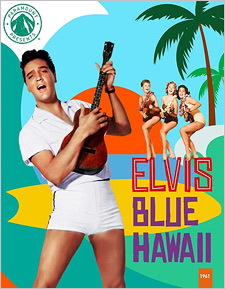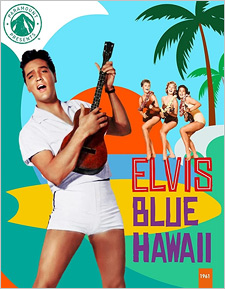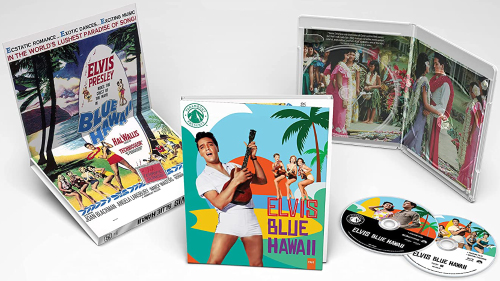Blue Hawaii (4K UHD Review)

Director
Norman TaurogRelease Date(s)
1961 (November 15, 2022)Studio(s)
Paramount Pictures (Paramount Presents #36)- Film/Program Grade: B-
- Video Grade: A-
- Audio Grade: C
- Extras Grade: C+
Review
At the time of its release, critics described Blue Hawaii as “bland” and “harmless.” Bland it isn’t, but harmless it is. But like most movies starring the undisputed king of rock and roll, it’s also charming. The trappings of the plot are nothing more than a means of getting Elvis Presley to sing as many songs as possible to as many beautiful women as the screen will allow. The best Elvis movies had something a little more to them than that, such as Jailhouse Rock or King Creole, wherein they actually relied a little more heavily on a dramatic story and gave the man a chance to actually act, which he could. Blue Hawaii is certainly not that, but one can’t deny the whimsical appeal of it, not to mention that it’s one of the most beautiful-looking films in the Elvis movie repertoire, if not top of the heap.
Chad (Presley) is returning from the Army to his home in Hawaii where his devoted girlfriend Maile (Joan Blackman) is waiting. Chad’s overbearing mother Sarah Lee (Angela Lansbury) and father Fred (Roland Winters) are happy to have him home, but continue to push him into following in his father’s footsteps, by running the Great Southern Hawaiian Fruit Company. Chad wants none of it, opting instead to work elsewhere and spend more time with his girl and friends, attempting to prove that there’s more to him than doing exactly what’s expected of him.
The most successful aspect of Blue Hawaii was, of course, its soundtrack. Featuring the hits Can’t Help Falling in Love and Rock-A-Hula Baby, as well as the title song, it was one of the top-selling soundtracks of its era. The film itself is much of what detractors of Elvis’ movie career have a disdain for, which is a thin story to hang songs and scenes of Elvis with the ladies on. Like a lot of romantic comedy-type films, there’s much about it that doesn’t hold up, including women who are total pushovers for Chad, even if he’s kissing other women right in front of them (and in one instance, being driven to suicide by his rejection, the darkest element of the film by far). When it comes to racial politics, it’s almost necessary to point out that Chad’s parents have an Asian servant named Ping Pong… draw your own conclusions there. Still, it’s odd that a film that portrays mixed-race relationships in a positive light takes several steps backwards elsewhere, but there it is.
Despite its shortcomings and eye-rolling moments (depending on your tolerance for casual infidelity and racism), what gets you through something like Blue Hawaii is Elvis’ charm, his music, and the gorgeous location work. After all, it’s what sold the film in the first place and made it such a big hit—one of the biggest Elvis movie hits overall, and there’s nothing wrong with that.
Blue Hawaii was shot by director of photography Charles Lang on 35 mm film using Panavision cameras and anamorphic lenses, finished photochemically, and presented in the aspect ratio of 2.35:1. Paramount brings the film to Ultra HD for the first time as #36 in their Paramount Presents line with a 4K restoration of the original Technicolor camera negative, graded for High Dynamic Range (HDR10 and Dolby Vision options are included). Besides the optical transitions and opening credits being digitally re-created, this is a very natural, organic presentation that reproduces the look of the film faithfully, even the swordfish-fishing stock footage at the beginning, which is the weakest area of the presentation. It’s pristine with amazing clarity and gorgeous color, of which the HDR grades take full advantage of. Blues, reds, and greens are rich with detail, while blacks are deep with excellent contrast. The bitrate is slightly erratic, primarily sitting in the 60 to 80Mbps range, but it’s an otherwise beautiful presentation.
Audio is included in a newly-restored English 5.1 Dolby TrueHD track, as well as German and French 2.0 mono Dolby Digital. Subtitle options include English, English SDH, and French. The lack of the film’s original mono soundtrack is frustrating since it’s included in Dolby Digital form on the accompanying Blu-ray. Meanwhile, the 5.1 manages to offer only a mild multi-channel experience. The surrounds are not put to any use outside of giving the soundtrack more space to breathe, not to mention the fact that the track is too quiet, requiring a volume adjustment. When it’s raised to a more appropriate level, dialogue is discernible while music and score have only decent heft. Atmos and 7.1 remixes aren’t really necessary for a film like this, but the 5.1 experience mostly fails at even reaching reference quality. If the original mono track had been included in lossless quality, all would have been forgiven.
Blue Hawaii on 4K Ultra HD sits in a clear amaray case alongside a 1080p Blu-ray and a still from the end of the film on the insert with a quote from film historian James L. Neibaur. Everything is housed in a slipcover which opens from the front to reveal the original theatrical poster. There are no extras included on the UHD, but the Blu-ray features the following:
- Audio Commentary by James L. Neibaur
- Blue Hawaii Photo Scrapbook (HD – 78 in all – 5:29)
- Original Theatrical Trailer (SD – 3:14)
The audio commentary features the aforementioned film historian James L. Neibaur, author of The Elvis Movies. Neibaur fills the track with information about the film and its soundtrack, offering quotes and anecdotes along the way, while also examining this period in Elvis’ career as a movie star, post-Army. He drops out a few times, but it’s certainly an educational track if you’re interested in learning more about the film. The Blue Hawaii Photo Scrapbook offers a collection of 78 stills of behind-the-scenes photos and promotional photos. Also included is the original theatrical trailer in standard definition. It’s too bad that more of the promotional materials, as well as the film’s soundtrack, couldn’t be included somehow.
Purveyors of cinema as an art form won’t get much out of Blue Hawaii, but for others who enjoy Elvis Presley and his more lighthearted efforts, this is practically the cream of the crop. The UHD is a mostly positive experience, though fails when it comes to its audio, which one might argue is just as important, if not more so, than its visual representation.
- Tim Salmons
(You can follow Tim on social media at these links: Twitter and Facebook. And be sure to subscribe to his YouTube channel here.)


